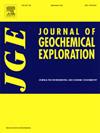Formation of uranium-, vanadium- and chromium-bearing reduction spheroids in karst bauxite of the Unterlaussa mining district (Austria)
IF 3.4
2区 地球科学
Q1 GEOCHEMISTRY & GEOPHYSICS
引用次数: 0
Abstract
Reduction spheroids are mm- to cm-scale spheroidal features that are formed by reduction processes and are mainly known from siliciclastic red beds. They consist of a bleached halo around a dark core that contains highly elevated contents of redox-sensitive elements such as U, V or Cr when compared to the host rock. Their formation mechanism is still poorly understood and reduction spheroids in rocks that are not associated with siliciclastic red beds are more than underexplored.
Here, we present geochemical and mineralogical results of U-bearing reduction spheroids hosted in karst bauxite of the Unterlaussa mining district (Austria). The goals of this paper are to (1) better understand the formation mechanism of reduction spheroids in non-siliciclastic host rocks that are not associated with typical red beds, and (2) to shed light on the mechanisms of U enrichment in karst bauxites. To this end, we used laser ablation-inductively coupled plasma-mass spectrometry (LA-ICP-MS), scanning electron microscopy (SEM), micro-X-ray fluorescence (μ-XRF) and Raman spectroscopy.
Among several enriched elements such as ΣREE (La-Lu) up to 2.6 wt% or V up to 7.6 wt%, high contents of U and Cr are most characteristic for the dark cores of the reduction spheroids. Uranium-rich reduction spheroid cores with local contents of up to ∼47 wt% U were identified along with almost U-free cores, which can often be found next to each other. The U-bearing mineral was identified as carnotite and a paragenesis of newly described secondary spherical and acicular Cr-V-Al minerals was found responsible for the high Cr contents in the reduction spheroid cores. The reduction spheroids were formed shortly after the burial of the karst bauxite by an unsorted clay-rich sediment and two possible origins for mobilized U, V and Cr are discussed. In the most likely model, U-, V- and Cr-rich material together with organic matter were admixed during a redeposition of the uppermost zone of the karst bauxite. After the burial of the karst bauxite, the decomposition of the organic matter in this mixing zone locally mobilized elements by mineral dissolution, and organic-rich particles beneath the mixing zone generated locally reducing conditions that immobilized U, V and Cr in the developing reduction spheroid cores. This mechanism is suggested to be of significance for the formation of U-rich karst bauxites in general.
This paper establishes karst bauxite as a host rock of reduction spheroids and describes a possible process of U enrichment in karst bauxites. With this publication we provide evidence that reduction spheroids are not formed by a single mechanism which would allow a priori inferences from their occurrence in the geological record, and we present a model for the formation of U-rich karst bauxites.
奥地利昂特劳萨矿区岩溶铝土矿中含铀、钒、铬还原球的形成
还原球体是由还原过程形成的毫米至厘米尺度的球体特征,主要存在于硅塑性红层中。与宿主岩石相比,它们由一个围绕着深色岩心的漂白光晕组成,其中含有高浓度的氧化还原敏感元素,如U、V或Cr。它们的形成机制尚不清楚,与硅塑性红层无关的岩石中的还原球体尚未得到充分勘探。本文报道了奥地利Unterlaussa矿区岩溶铝土矿中含铀还原球体的地球化学和矿物学结果。本文的目的是:(1)更好地了解与典型红层不相关的非硅质承载岩中还原球体的形成机制;(2)阐明岩溶铝土矿中铀的富集机制。为此,我们采用了激光烧蚀-电感耦合等离子体质谱(LA-ICP-MS)、扫描电子显微镜(SEM)、微x射线荧光(μ-XRF)和拉曼光谱。在还原球的暗核中,富集元素ΣREE (La-Lu)含量高达2.6 wt%, V含量高达7.6 wt%,其中U和Cr含量高是最显著的特征。局部铀含量高达~ 47 wt%的富铀还原球状核与几乎不含铀的核一起被鉴定出来,这些核通常相邻发现。含铀矿物被鉴定为卡诺岩,新描述的次生球形和针状Cr- v - al矿物的共生作用是还原球状岩心中Cr含量高的原因。这些还原球体是在富粘土未分选的沉积物掩埋岩溶铝土矿后不久形成的,并讨论了活化U、V和Cr的两种可能来源。在最可能的模型中,富U、V、cr物质与有机质在喀斯特铝土矿最上层的再沉积过程中混合。喀斯特铝土矿埋藏后,混合带有机质的分解作用通过矿物溶蚀作用局部调动元素,混合带下方富有机质颗粒产生局部还原条件,将U、V、Cr固定在发育的还原球型岩心中。这一机理对富铀岩溶铝土矿的形成具有重要意义。本文建立了岩溶铝土矿作为还原球体的寄主岩,并描述了岩溶铝土矿铀富集的可能过程。通过这篇文章,我们提供了证据,证明还原球不是由单一机制形成的,这将允许从它们在地质记录中的出现进行先验推断,并且我们提出了富铀喀斯特铝土矿形成的模型。
本文章由计算机程序翻译,如有差异,请以英文原文为准。
求助全文
约1分钟内获得全文
求助全文
来源期刊

Journal of Geochemical Exploration
地学-地球化学与地球物理
CiteScore
7.40
自引率
7.70%
发文量
148
审稿时长
8.1 months
期刊介绍:
Journal of Geochemical Exploration is mostly dedicated to publication of original studies in exploration and environmental geochemistry and related topics.
Contributions considered of prevalent interest for the journal include researches based on the application of innovative methods to:
define the genesis and the evolution of mineral deposits including transfer of elements in large-scale mineralized areas.
analyze complex systems at the boundaries between bio-geochemistry, metal transport and mineral accumulation.
evaluate effects of historical mining activities on the surface environment.
trace pollutant sources and define their fate and transport models in the near-surface and surface environments involving solid, fluid and aerial matrices.
assess and quantify natural and technogenic radioactivity in the environment.
determine geochemical anomalies and set baseline reference values using compositional data analysis, multivariate statistics and geo-spatial analysis.
assess the impacts of anthropogenic contamination on ecosystems and human health at local and regional scale to prioritize and classify risks through deterministic and stochastic approaches.
Papers dedicated to the presentation of newly developed methods in analytical geochemistry to be applied in the field or in laboratory are also within the topics of interest for the journal.
 求助内容:
求助内容: 应助结果提醒方式:
应助结果提醒方式:


